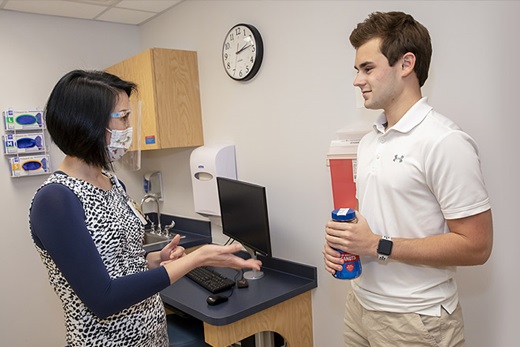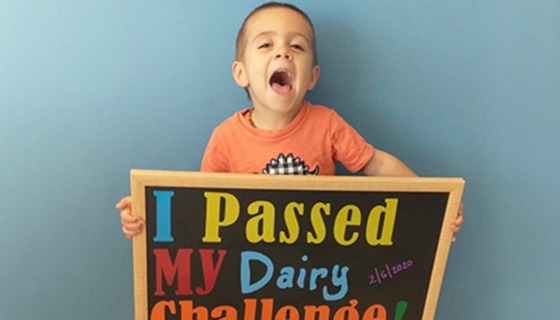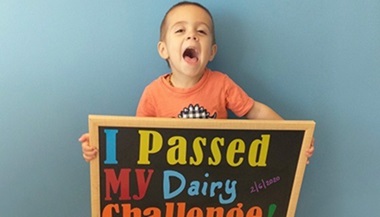Patient Story
Allergic Reaction: Ian’s Story

Ian was watching a movie in class when it hit him out of nowhere.
“I started getting a really bad cough and heavy breathing,” he recalls. “I hived out. It was really scary.”
The then-16-year-old was having a severe allergic reaction, commonly known as anaphylaxis. But it wasn’t from something he knowingly ate. It was from something he merely touched — his friend's water bottle.
“I drank out of a friend’s water bottle, and he had eaten peanut butter,” Ian explains.
Ian went home and took an antihistamine, and luckily, recovered. But his mom, Katie, says it could have been much worse.
“That small minute amount of peanut butter on the water bottle mouthpiece caused that big of a reaction,” Katie says. “He was so sensitive that one peanut could have killed him.”
When he was a young boy, Ian was first diagnosed with food allergies to egg and peanut. He outgrew his egg allergy, but his peanut allergy remained. From there, he avoided peanuts, until this accidental encounter. Katie decided it was best to give him a new round of allergy testing as a teenager, which was done at a private practice.
“The nurses had to rush in and give him an epinephrine injection and antihistamine because of his response to a simple skin prick test using peanut extract,” Katie says.
Ian was referred to the new Johns Hopkins All Children’s Food Allergy Clinic. This was the perfect fit for him, where he became the first patient to undergo a new oral immunotherapy (OIT) called Palforzia, the first FDA-approved treatment for peanut allergy in children ages 4-17. Johns Hopkins All Children’s is the first place in the state of Florida to offer it.
“It can save your life when you accidentally ingest a small amount of peanut. This gives families that peace of mind,” says Panida Sriaroon, M.D., medical director of the Food Allergy Clinic at Johns Hopkins All Children’s Hospital. “It doesn’t mean that the patient can go home and eat a half of jar of peanut butter freely, but the treatment could get them from not tolerating a small amount of peanut to tolerating at least one peanut daily.”
During the peanut OIT, patients are closely monitored in the clinic for reaction, and they will consume a precise, tiny amount of peanut powder, which is mixed into soft food. They take the same dosage daily at home for two weeks, then the dosage is increased in clinic, and taken daily at home for another two weeks. This buildup treatment is repeated until the patient is finally able eat and tolerate Palforzia in the amount equal to one peanut daily — it takes about six months. Patients then continue to take this dosage of Palforzia daily, as maintenance treatment.
At this point, some might choose to convert to eating peanut in food forms, such as peanut butter, peanut powder, or even peanut candies such as peanut M&Ms or Reese’s Pieces. The ultimate goal is to give patients a higher level of protection and have milder or no reaction when they accidentally eat peanut. Some families may want to extend the buildup treatment to have a higher level of protection, where the patient can eat three to eight peanuts a day.
It is important to follow the daily regimen at home on a long-term basis, which is why before the treatment the patients and families have an hour-long, in depth consultation with the Food Allergy Clinic team about what to expect and typical protocol for successful outcomes.
“Patients have to be dedicated with the support and buy-in from their family because consistency is key,” Sriaroon says. “We are giving the kid what they are allergic to, so they might still react at any time. We advise that they refrain from physical activities/exercise for two hours after each dosing, as the treatment could cause the body to react more sensitively. If a patient is ill or has a fever, we may need to lower the dosage slightly for a few days before resuming the previous amount.”
This routine must continue every day for the rest of their life to maintain desensitization in order to keep them safe from accidental ingestion.
"I really cannot stress how phenomenal the doctors and nurses were. They were so knowledgeable and we were on this ride together."
Katie, Ian's mom
They were so interested and hands on in every single step of the process and protocol,” Katie says. “We never left the department with questions. They always had answers.”
Ian has done well and graduated to an entire peanut, just as he recently graduated high school. It’s a huge sigh of relief for his parents who are proud to send him off to Florida State University this fall, the ninth person in their family to attend the college.
“It truly has been a gift to us going through this entire peanut OIT process,” Katie says. “His daily peanut intake is our insurance policy, and we are so thankful and so lucky that we have it.”
Ian now eats one peanut daily. Although he still needs to carry injectable epinephrine in case of an emergency, he feels safe knowing that his body now tolerates one peanut a day. If he runs into peanuts again, he won’t react like he did to the water bottle in school. And that’s great news — because he has some big plans ahead, which include going to medical school and becoming a doctor one day.
Ian's Care Team
Allergy/Immunology Program at Johns Hopkins All Children's Hospital
Johns Hopkins All Children’s Hospital in St. Petersburg, Florida, provides a range of testing for children and teens with allergies and immunologic conditions. Common symptoms you might see if your child has an allergic or immunologic condition can include chronic runny nose, cough, itchiness or hives; reaction to certain drugs, insects or vaccines; or recurrent infections.





